2004 VOLKSWAGEN GOLF PLUS Ecu
[x] Cancel search: EcuPage 149 of 541

Luggage net
Fig. 92 the luggage comportment: luggage net
hung horizonta lly.
on page
The luggage net h e lp s preve nt lig ht er luggage from
s hiftin g. Th e luggage net a ls o h as a built-in zip
p e re d poc ke t ca n h old small er ite m s.
There are seve ra l w ays to ins tall th e lu gg age net in
th e lugg age compartm ent.
Example 1: Securing the luggage net flat on the
luggage compartment floor
th e lu gg ag e net h ooks to the tic-clow n fig. 92 Th e luggage net zipp er must face upwa rds.
th e lu ggage ne t ho oks to th e tie-clow n
hook s
Example 2: Securing the luggage net to the
loading edge
th e s hort lu ggage net hook s to th e tie
d o wn fig. 93
A !!ach the lo o ps to the sh opping bag hooks
Before driv in g
Fig . 9 3 and hooks for hang ing the luggage net.
Removing the luggage net
The install ed lu ggage net is stre tc h ed
He move th e hooks and loop s of th e lu gg age ne t
fro m the tie-clow n hoo ks o r sh op pi ng bag ho oks.
th e lu gg age ne t in the lu ggage compart
m ent.
Alway s hold th e luggage net hooks firmly
wh en in stalli ng and removing the net so tha t the hooks do not snap back and hit you.
Alway s faste n th e lu ggag e net hooks in the
c orre ct orde r described. If one of the hooks on th e luggag e net snaps back, it may injure you.
Page 150 of 541
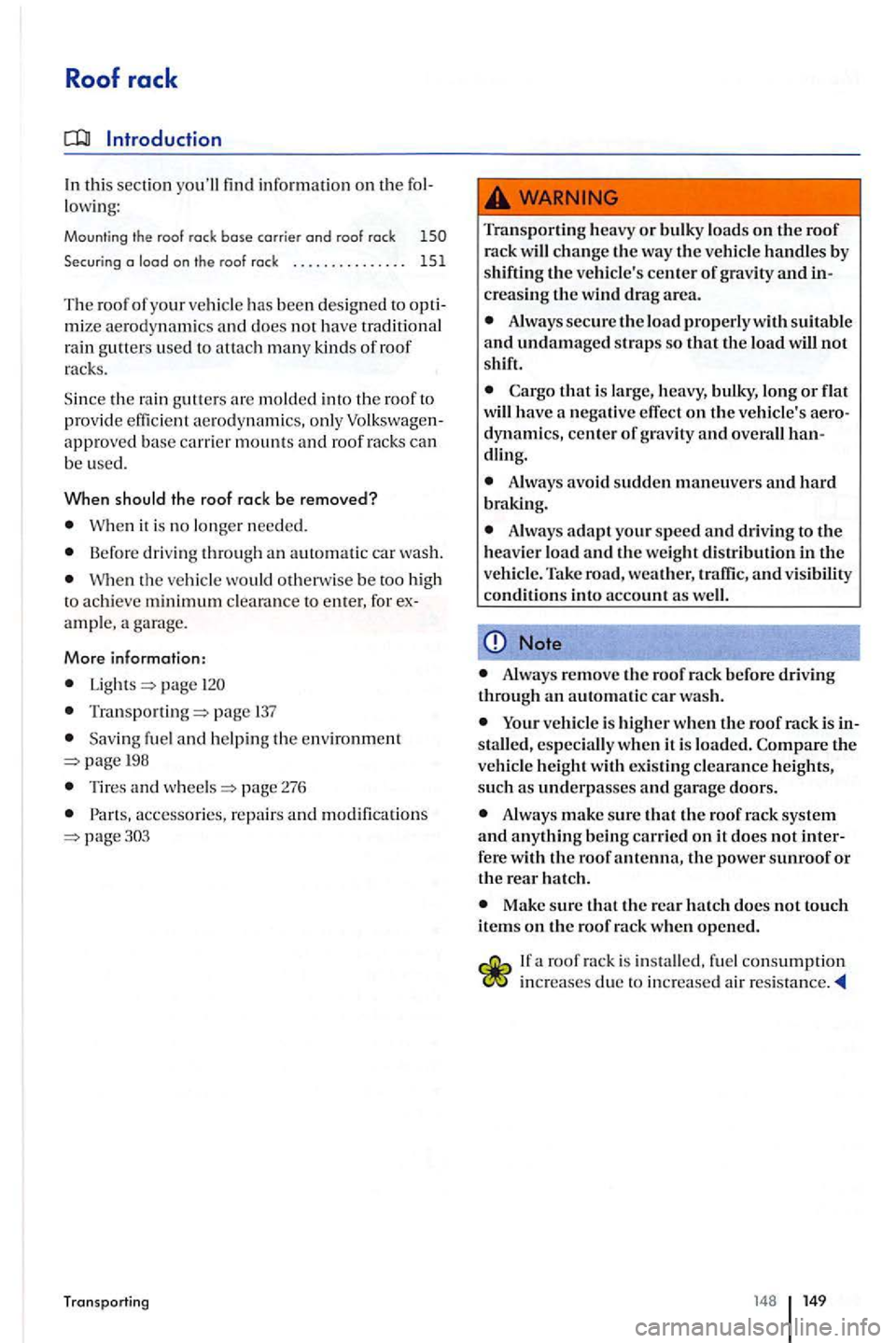
Roof rack
this section you'll find informatio n on th e lowin g:
Mounting the roof rock bose carrier and roof rock
mize aerod ynamics and does not have tradit io nal
rain gutters used to attach many kinds of roof
ra cks.
the rain gutte rs are m old ed into the roof to prov ide efficient ae rody nami cs, only approved base carrie r mounts and roof racks can be u se d.
When should the roof rack be removed?
it is no lo nge r need ed.
Befo re dri vin g throug h an automatic car wash.
th e ve hicl e would otherw ise be too high to achieve minimum clearance to enter, for ample, a ga rage.
More information:
page
Tran sp o rtin g=> page 137
Sav ing f uel and h e lping the en vironment 198
Tires and page 276
Parts, a ccesso ries, repa irs and modifica tio ns
Transporting heavy or bulky loads o n the roof rack will change the way the ve hicl e handles by shifting the ve hicl e's cente r of gravity and creasing the wind drag area.
Always secu re the load properly wit h suitable and undamaged straps so that the load wiH not s hift.
Cargo that is larg e, heavy, bulky, long or flat
will have a negativ e effect on the vehicle's
dling.
Always avoid sudden maneuvers and hard braking.
Always adapt your speed and driving to the heavier load and the we ight distribution in the ve hicle. Take road, weather, and vis ibili ty
conditions into account as we ll.
Note
Always remove the roof rack before driving through an automatic car wash.
vehicle is higher when the roof rack i s stalled, especially when it is loaded. Compare the ve hicl e height with ex isting clearance heights,
s u ch as underpasses and garage doors.
Always make sure that the roof rack system and anything being carried on it docs not
Make sure that the rear h atc h does not touch items on the roof rack when open ed.
a roof rack is installe d, fue l co nsumption inc reases due to in creased air resis tance.
148 149
Page 152 of 541
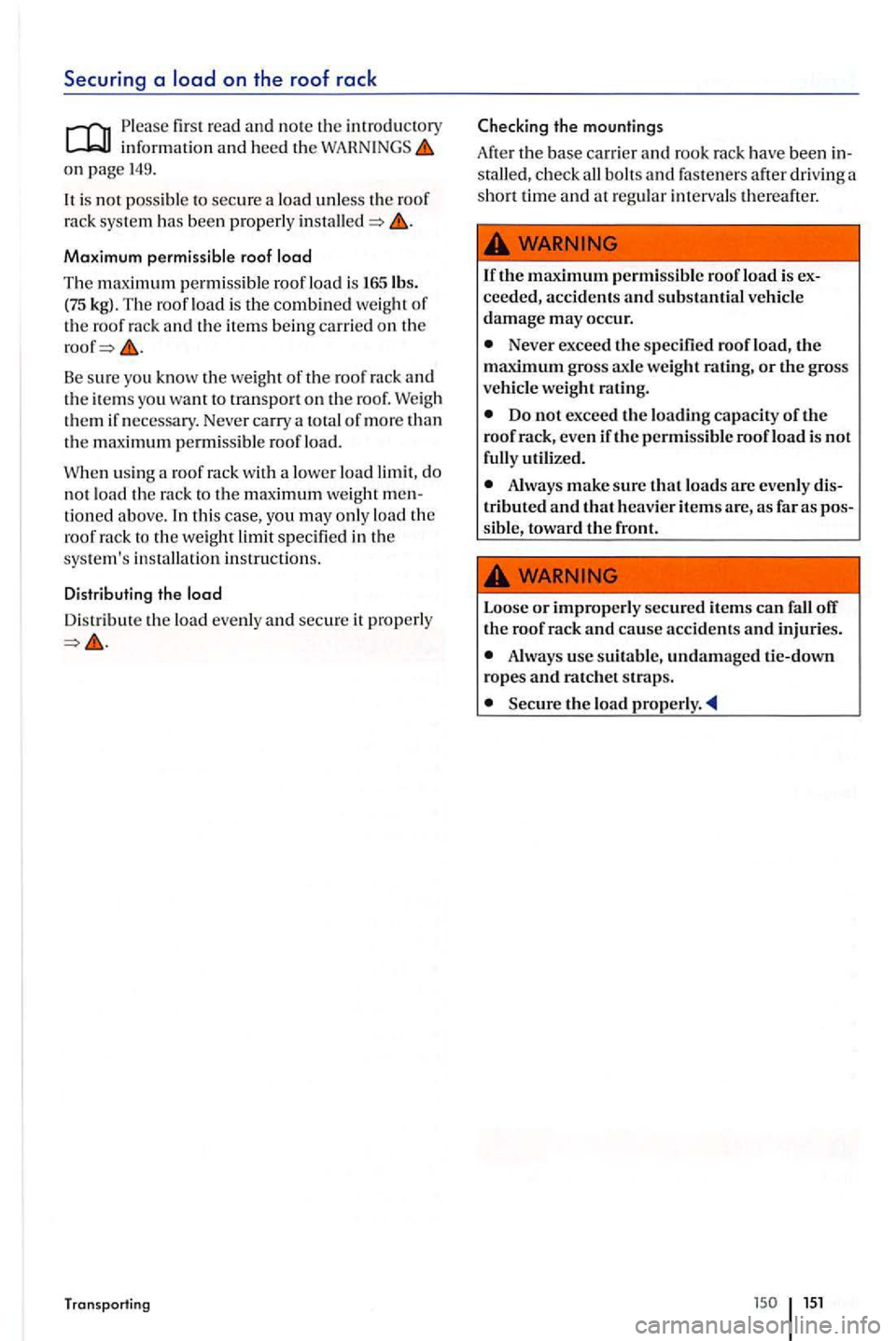
Securing a
first r ead and note the introdu ctory information and heed the on pag e 149.
It is no t pos sibl e secure a load unless the roof rack sys te m has bee n pro perly
Maximum permissible roof load
Th e ma ximum permi ssibl e roof load is l65lb s. (75 kg). Th e roof load is the combined weight of
the roo f ra ck and the item s bein g carri ed on th e
Transporting
Checking the mountings
Afte r the base carrier and rook rack have been in
s talled, check all bolt s and faste n ers after drivin g a
s h ort time and at regular int erva ls th ereaft er.
If the maximum permissible roof load is ex
ceeded, accidents and substantial vehicle damage may occur.
Never exceed the specified roof load, the maximum gross axle weight rating, or the gross
veh icle weight rating .
Always make sure that loads are evenly dis
tributed and that heavier it ems are, as far as pos
sible, toward the front.
Loose
or improperly secured item s can fall off the roof rack and cause accid ents and injuri es.
Always use suitabl e, undamaged tie-down
ropes and ratchet straps.
the load
151
Page 153 of 541
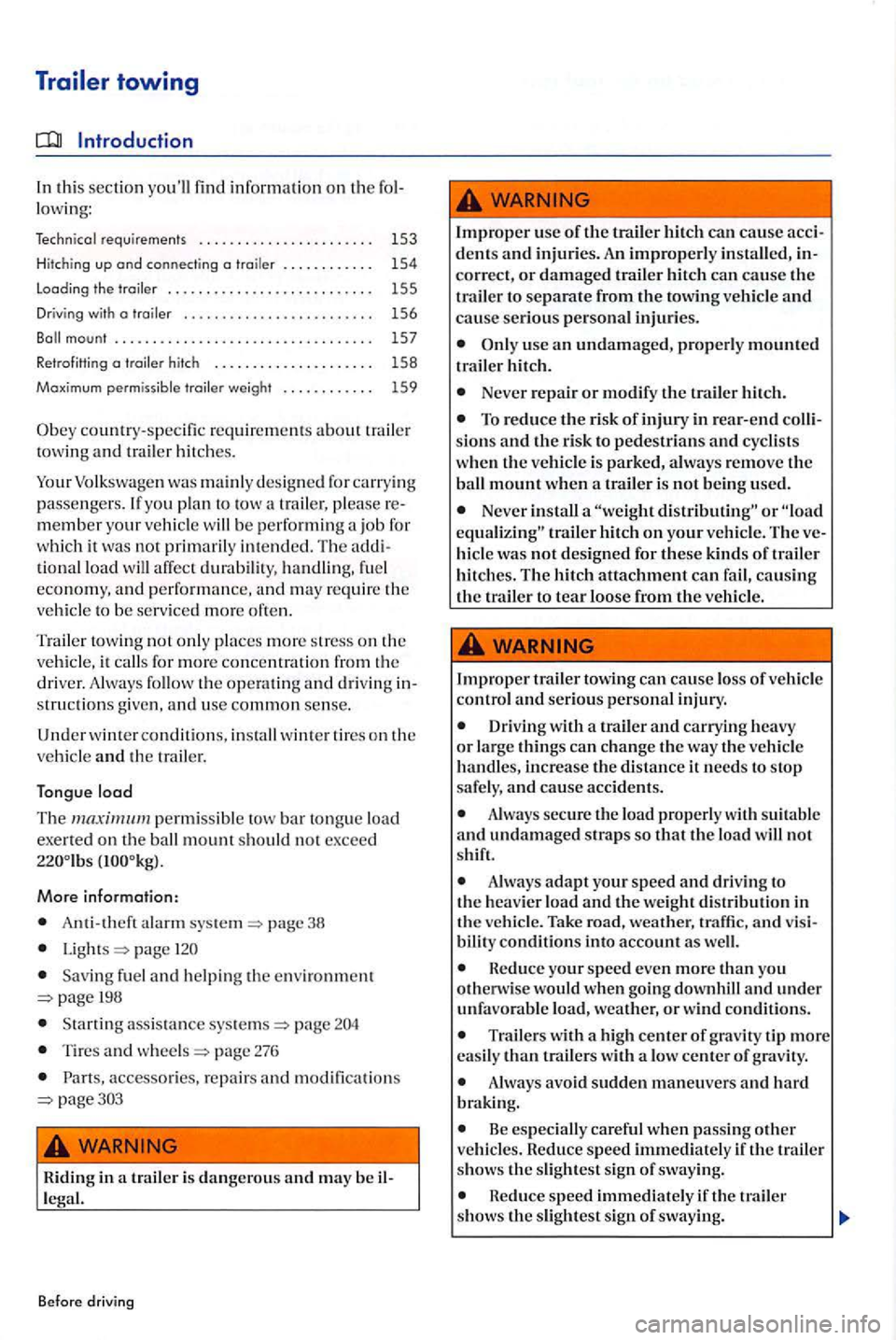
In thi s section lowing:
Techni cal requirem ents ..... ............•. . . . 153
Hitching up and connecting a trailer . . . . . . . . . . . 154
Loading the traile r . . . . . . . . . . . . . . . . . . . . . . . . . . 155
Dri ving with a trailer . . . . . . . . . . . . . . . . . . . . . . . . 156
mo unt . . . . . . . . . . . . . . . . . . . . . . . . . . . . . . . . 157
Retrofitting a traile r hitch . . . . . . . .
country -s pecifi c requir em elll s about trailer
towin g and trai ler hit ches.
Your Volkswage n was mainl y designed f o r ca rryin g
passen gers. If yo u plan to tow a trail er, ple ase member your ve hicl e will be perfo rming job for
which it wa s no t primarily in tende d . Th e tion alload will aiTec t durabi lity, handling, fu el
economy, and p e rf ormance , and may re quir e th e
veh icle to be service d mo re ofte n.
T ra
iler towing only place s more str ess on th e
ve hicle , calls for more concentration from the
dri ver. Always follow the o p era ting and dri ving s tru ction s give n, and use common sense.
perm issible bar load
exerted on th e ball moulll should not exceed
More informati on:
ala rm pag e 38
page
Sav ing fuel and h elpin g th e en vir onment 198
S tarti ng ass istanc e page
T ires and page 276
acc essories, repairs and modifica tion s
Riding in a trailer is dangerou s and may be legal.
Before driving
Improper use o f the trailer hitch ca n cause
correct, or damaged trailer hitch ca n cause the
trailer to separate from the towing ve hicl e and cause se rious personal injuri es.
use an undamaged , properly mounted trailer hitch.
Never repair or modify the trailer hitch.
To reduce the risk of injury in rear-end sio ns and th e risk to pedestrians and cyclists when the vehicle is parked, always remove the ball mount when a trailer is not being used.
Neve r in stall a or hitch on you r ve hicle. The hicle was not design ed for these kind s of trailer
hit ch es. The hitch attachment can fail , ca using
th e trailer to tear loose from
Improper trailer towin g can cause loss of vehicle
co ntrol and serio us personal injury.
Driving with a trailer and carry ing heavy
o r large things can change th e way the vehicl e handles, increase the distance it need s to sto p
safely, and ca use accidents.
Always secure the load properl y with suitable and und amaged straps so that th e load will not
s hift .
Alw ays adapt your sp ee d and driv in g to
th e heav ier load and weight distribution in the vehicle. Take road, weather, traffic, and
Reduce your s pe ed even more th an yo u otherw is e would when going downhill and und er
unfavorabl e lo ad, weather, or wind co ndition s.
a lo w center of grav ity.
Always avo id sudd en maneu vers and hard
Be especiall y caref ul when pas sin g other ve hicl es. Reduce sp eed immediately if the traile r
shows the slightest sig n of swaying.
Page 154 of 541

Never drive fa ster than mph mph -
Never try to stop the swaying by accelerating.
fir st read a nd note the imroductory informatio n and heed the on page
If the ve hicle was fac tory-equipped with a trail er
hi tch, all technical and lega l require m em s fo r
trailer towi ng have already been m et.
use a trai le r hitc h w hich is approve d for the
g ro ss wei ght rating of the trailer yo u want to tow. The hit ch mus t be s uitabl e fo r your vehicle and
tr ailer and be securely bolt ed to the ve hicle's chassis. use a trail er hitc h with a re movable ball mount. Alway s check and follow the trail er
hi tch manufacturer's information. Neve r in stall a o r tra ile r hitch on yo u r vehicle.
D o n
ot use a bumper-mounted trai le r h itch
Never insta
ll a trailer hitch on the bumper o r or on th e bumper mountings. The traile r hit ch mus t not in terfe re wit h the impact-absorbing bumper syste m . D o not make any changes to the ve hicl e exhaust and brake sys te m s. From time to time, check that all hitch m oumin g bolts are securely fas ten ed . W hen not towing. re m ove the trailer hi tch. Thi s help s ke ep the hitch from causin g damage if your ve hicl e is hit from behind.
Eng ine cooling syste m
Tow ing a tra
iler makes the e ngin e
If you arc dri ving a new ve hicle or ave-do not tow
a t railer
mil es
need
load it h as to pull.
When you are not towin g, remove the trailer
models need trail er hit ch to tow or tow -s tart other ve hicl es. may
Trailer brakes
If your trail er has its own brake s, make sure it
meet s all regulati ons. Th e trailer bmke sys te m
mu st never be directly connecte d to the ve hicle's brake system .
Safety c
hain s
A lways u
se safety chains be tween yo ur vehicle and
th e trailer.
Trail er rear lights
Tra
ile r lights must meet all regulation s.
Neve r
connect the tmil er l ights directly to the e lec
trica l s ys tem of your ve hicl e. Be su re to check wit h
your authorized Volkswagen dealer or authorized Volk swagen Faci lit y about correct w iring, sw itches and re lay s.
Outside mirrors
I f
the s ta ndard ou ts id e mirror, addition al outs ide m irrors are needed and required b y law in so me coumrie s I states I provin ces. The o uts id e
mirr o rs mus t b e adjuste d b efore driv in g and g ive good v iew to the rear.
Max im um power consump tio n f or th e trailer
D o no t excee d the power ratin gs liste d in the chart below.
E l
ectrical consumers power con-sumptio n
Taillight s
Turn signals pe r sid e 54 wat ts
Page 156 of 541
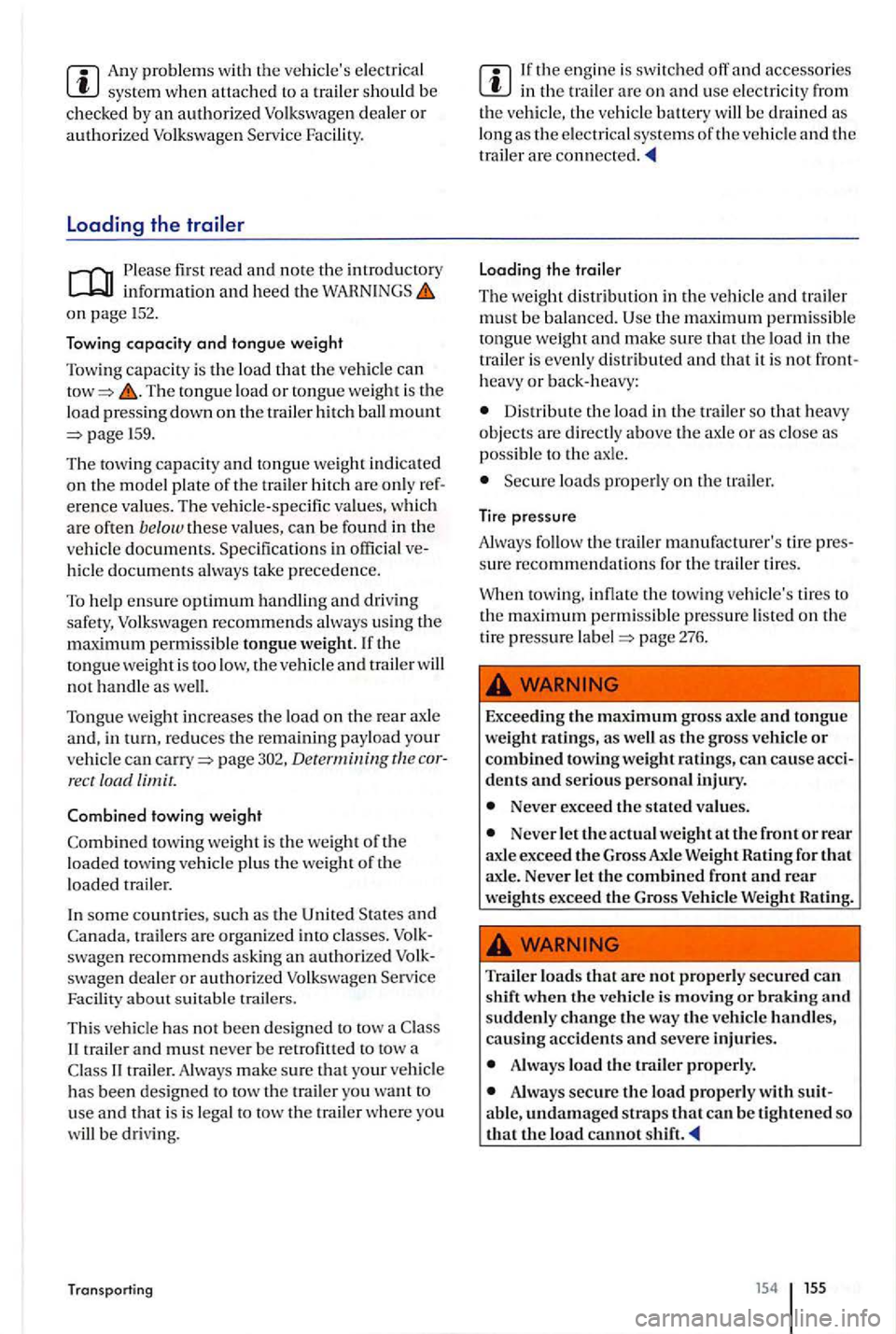
Any problems with the vehicle's elec trica l system when attached to a trailer should be chec ked by an authorized Volkswagen dealer or authorized Volkswagen Service Facility.
Loading the trailer
Pleas e first read and note the introductory information and heed the on page 152.
Towing capacity and tongue weight
Towing capac ity is the load that th e vehicle can
159.
The towing capacity and tongue weigh t indicated on the model plate o f the trail er hit ch are only re f
e ren ce value s. The vehicle-specific values, which are often below these values, can be found in the vehicle document s. Specificat ions in officia l ve
hicl e documents alwa ys take precedence.
To help en sure optimum handling and driving safe ty, Volkswagen recommends always using the
not handle as well.
Tongue weight increases the load on the rear axle and, in turn, reduces the remaining pay load your ve hicl e can cor
rect load limit.
Combined towing weight
towing weight is th e we ight of the
l oaded tow in g vehicle plus th e we igh t of th e
l oaded trailer.
In some countries, su ch a s th e States and Ca nada, trailer s are organ ize d in to cla sses. swagen recommend s askin g an authori zed swage n dealer or auth orized Volksw agen Se rvice
Facili ty about suitabl e trailer s.
Thi s
vehicle has not been desig n ed to tow a traile r and must n eve r be retrofitted to tow a II trailer. Always make sure that your vehicl e has been designed to tow the trai le r you want to use and that is is legal to tow the traile r where you be driving.
T ronsporting
Loading the trailer
The weig ht dist ribution in the vehicle and tra iler
mu st be balanced. th e maximum permissible
tongue weight and make sure that the load in the
trail er i s eve nly di stributed and that it is not front
h eavy or back-heavy:
Distribut e th e load in th e trail er so that heavy objec ts are directly above the axl e or as close as
po ssibl e to the
Secu re load s properly on the trail er.
Tire pressure
Always follow th e trail er manufac turer' s tir e pres
s ure recommendations fo r the trailer tires.
W h
en towing, inflat e th e towin g vehicl e's tir es to the maximum permissible press ure listed on th e
tir e pressure la bel pag e 276.
Exceeding
the maximum gross axle and tongue weight ratings, as well as the gross vehicle or combined towing weight ratings, can cause accidents and serious personal injury.
Never exceed the stated va lues.
Never let the actual weight at the front or rear axle exceed the Gross Axle Weight Rating for that
axle. Never let the combined front and rear weights exceed the Gross Vehicle Weight Rating.
Trailer loads
that are not properl y secured can shift when the vehicl e is moving or braking and suddenly change the way the vehicle handles,
causing accidents and severe injuries.
Always load the trailer properly.
Always secure the load properly with suitable, undamaged straps that can be tightened so that th e load cannot shift.
154 155
Page 161 of 541
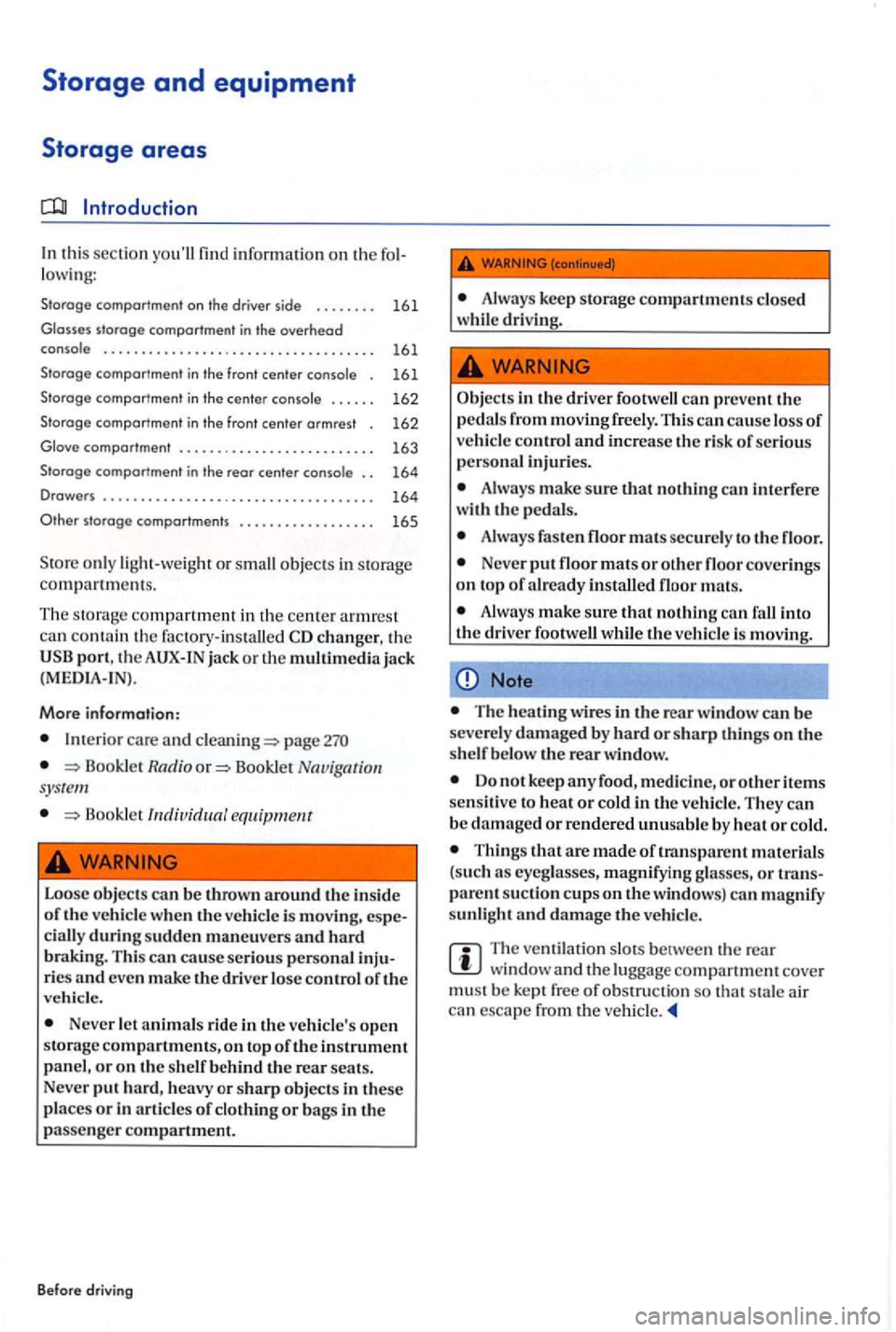
th is sect ion you'll find informatio n on the
. 161
Storage comportment in the center . . . . . . 162
S torage comportmen t in the front center armrest . 162
comportment . . . . . . . . . . . . . . . . . . . . . . . . . . 163
Storage comportment in the rear center . . 164
Drawer s . . . . . . . . . . . . . . . . . . . . . . . . . . . . . . . . . . . . 164
storage comportments . . . . . . . . . . . . . . . . . . 165
objec ts in storage
compa run ents.
Th e storage co
mpartm ent in t he center armres t
can
p o rt , th e jack or th e multimedia jack
(MEDIA-IN).
More information:
care and
Bookle t Radio
Book letlndiuidual
Loose objects ca n b e thro wn around th e in sid e
o f the ve hicle when the v ehicl e is m oving,
ries and eve n make th e driv er lose control of the
ve hicle.
Neve r le t animals ride in the ve hicle' s op en
s tor ag e compartments, on top of the in strument
p an el, or on th e s helf behind rear seats.
Neve r put ha rd, heavy or sharp o bj ects in these places or in articl es of clo thing or bags in the
p asse nge r compartment.
Befor e dri vin g
Always kee p stora ge compartments closed
w hil e dri vin g.
Obje cts in the driver footw ell can preve nt the pedals fro m moving freely. This ca n cause loss of ve hicl e co ntrol and increase the risk of seriou s
p e rson al inju ries.
A lways make su re th at nothin g can interfe re
w ith th e pedal s.
Always faste n flo or mats securely to th e floo r.
Neve r put floor m ats or oth er floor coverings on top of alread y install ed flo or mats.
Always make sure that nothin g ca n fall into
th e driver f oo twell while the ve hicl e is m ov ing.
Note
Th e heating wire s in rear w indo w can be
seve re ly d am age d by h ard or sh arp thin gs on the
s h elf be low the rear wind ow.
Do not ke ep any food, medicin e, or o th er it em s sensitive to heat or cold in the vehicl e. They can
b e damaged or r endered unusable by heat or cold.
Things that a re made of tran sparent materials (su ch a s eye glasses, magni fying glasses , or
The ventilation slots betwee n th e rea r window and lu ggage compart ment cover must b e kep t f ree of obs truction so that stale air
ca n escape from the
Page 168 of 541
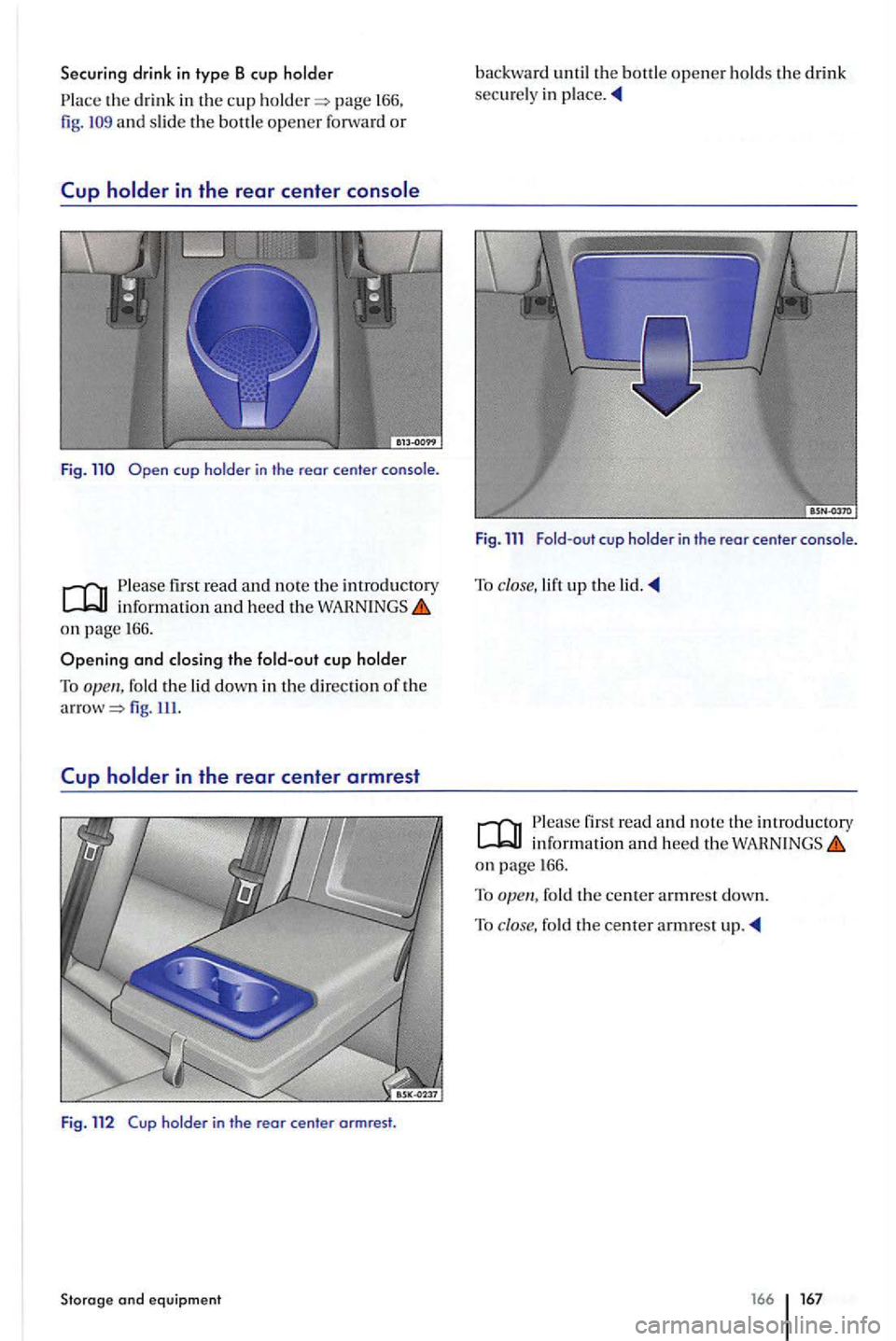
Securing drink in type B cup holder
page 166. fig. and s lide the bottle o pener forwa rd or
Cup
fir st read and note the introductory informati on and heed the WAHNlNGS on p age 166.
fold the lid down in the direc tio n of the fig . Ill.
Cup in the rear center armrest
Fig . 112
Fig. 111 Fo ld -out cu p h older i n the rear cente r c onso le .
To close, lift up the
first read and note th e introductory information and heed th e on page l66 .
To
f o ld the center armrest down.
T o
fold the armrest up.
166 167